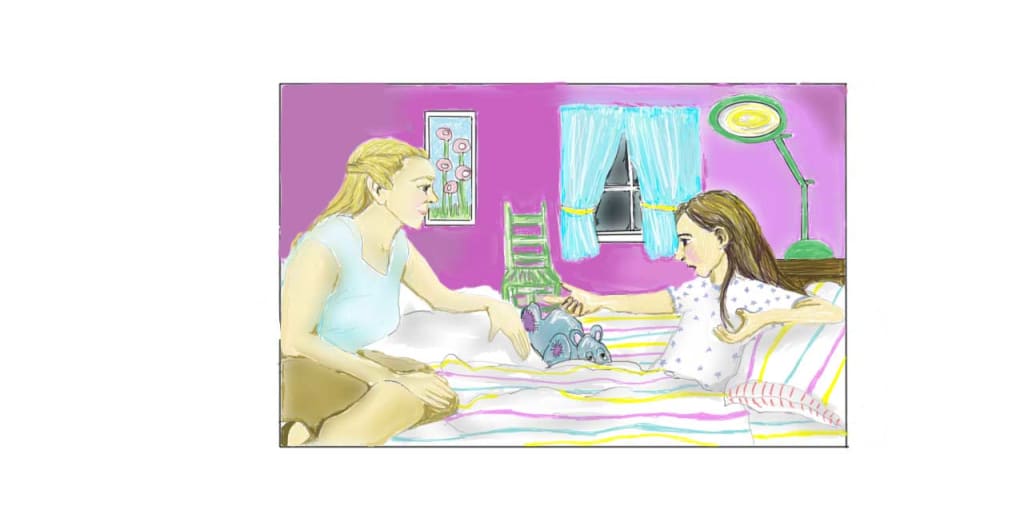ACTIVE LISTENING.
The Importance of Listening.

From since Jane was five years old she has been an outspoken child. When she failed to do as she was asked, Jane found reasons for the failure with the intention of putting herself in the right and to clear her of the fault.
Jane’s only fault was not looking at the speaking when her mother or anyone else was speaking with her.
On many occasions she failed to carry out the instructions her mother requested then found an excuse for the failure.
The kindergarten teacher complained to her mother Mrs. Goodman, that her daughter was not paying attention in class. Jane then blamed her peers for the distraction.
So one day after another mishap, Jane’s mother had a talk with her.
As usual, Jane played with her toys without looking at her mother who had been speaking to her.
“Listen to me June, active listening is important” said Mrs. Goodman.
“Mummy, what is “active listening?” asked Jane.
“It means to look at the speaker while you are listening” replied Mrs. Goodman.
“Mummy, I do not have a hearing disability, so do not need to look on the speaker, because I can hear with my ears. Only if someone is showing me something then I would need to look. But otherwise if you are only speaking to me I do not need to look.” replied Jane.
“You cheeky child, if you continue in this mindset you will missed out on important lessons and will not do well in school. But don’t forget what I just said about 'active listening'” replied her mother.
June usually attended kindergarten at a school on the same street where she lived. But at age six she got enrolled in a primary school a block away from her home.
To get to the school she had to cross a street that was not very busy. Her mother always drove her to school in the mornings and picked her up in the afternoons.
One day Jane said “Mummy you do not need to drive me to school because it is not far and all the children who are living close by are walking to school on their own”.
Because the road that Jane had to cross was not busy, Mrs. Goodman agreed because all the children in their neighborhood were walking to and from school by themselves anyway.
“You may not have other children to cross the street with you so might have to cross it alone. This is how you are to cross the road” replied Mrs. Goodman.
So Mrs. Goodman used her hand to demonstrate to Jane how to cross the street, but as always she did not look at her mother, but played with her toys while her mother spoke.
The first morning that Jane went to school on her own she Jane returned home with a smile on her face. “Mommy, I crossed the road all on my own with no problem”. She said.
“Well done” replied Mrs. Goodman.
The following evening when she came home she said; Mummy I was on my own and just as I crossed the road, a car came racing down the road behind me” she said.
“Didn’t you see the car coming before you cross?” asked Mrs. Goodman.
“No Mummy, I didn’t” replied Jane.
“Just be careful and make sure you look properly” replied Mrs. Goodman
Another evening, she came home with a similar story. “Mammy just as I was about to put my foot in the road to cross, a heard a loud “peeeeep” sound and I jumped back on the sidewalk, I saw a car that had suddenly breaked” said Jane.
Mrs. Goodman got a bit concerned for Jane’s safety. “That car was very near to you, so how is it that you did not see it”? Asked Mrs. Goodman.
“Mummy, might be the driver was blind and did not see me” said.
“Jane, you are the one to look out for the vehicles and not the drivers to look out to see you” replied Mrs. Goodman.
“I might have to take you to school again” said Mrs. Goodman.
“No, Mummy, no, please give me another chance” pleaded Jane.
“Okay, are you doing what I have instructed you to do before you cross the street?” asked Mrs. Goodman.
“Yes Mummy, I am doing exactly as you said,” replied Jane.
“Okay, let us pretend that you are going to school and you come to the place to cross. Now show me what you do before you cross the street” instructed Mrs. Goodman.
“Okay, Mummy, look and you will see that I am doing exactly as you said” replied Jane.
So Jane stood; she looked up in the sky and down on the ground, then stepped out on the road.
Her mother was shocked “What is that you are doing? I did not say that you should ‘look up in the sky and down on the ground’ then you cross” said Mrs. Goodman in a frightened tone of voice.
“But mommy that is what you said, that I should “look up and look down” then cross” replied Jane in an annoyed tone of voice.
“If you were paying attention with your eyes as well as your ears when I was giving you the instruction, then you would have seen that I demonstrated to you with my hands to ‘look up the road, then down the road’.
No wonder you did not see the cars coming. You could have been killed” replied Mrs. Goodman.
“But Mummy when you are driving and before you cross a street you always look ‘up in the sky and down in the car’ first” replied Jane.
“Yes, but I do not look up in the sky, I look in the rear view mirror to see if vehicles are behind me before turning” replied Mrs. Goodman.
“Okay, mummy, I never knew that” replied Jane.
“Listen darling, do not always go by what you see when you are given instructions, you are to look at the speaker. I know that in some cultures children are not allowed to look the speaker in the eyes when being spoken with. Also people with hearing disability hear only with their eyes but you do not belong to any of the above groups, so am expecting you to look at me and your teacher when you are being given instructions to follow” said Mrs. Goodman.
“Okay, mummy” replied Jane.
“Now let us pretend to practice crossing the road properly” said Mrs. Goodman.
So they pretended to be by the road again that Jane had to cross to get to the school. Jane pretended to look up the road, then down the road. “The road is clear, mummy” said Jane.
“Then cross quickly before a vehicle comes racing down the road” said Mrs. Goodman.
“What do you learn from this experience?” asked Mrs. Goodman.
“Mummy, I learn the meaning of active listening, that when someone is speaking to me that I should look at the speaker and listen.
“Okay, good. I want you to practice ‘active listening’ in school as well for this is the only way that you will learn properly.
Remember that “Active Listening” is the key to effective learning.
“Mummy, I am going to ask my teacher to let me share my experience with the class, because when the teacher is doing activities with us on the carpet, he keeps telling some of the children to pay attention” said Jane.
“That is a good idea to tell everyone that ‘active listening’ is important” replied Mrs. Goodman.
So the teacher allowed Jane to tell the class about her experience regarding ‘active listening’. When Jane returned home she said:
“Mummy when I told the class what had happened to me when crossing the road, everyone busted out in a laughing fit, because they found the story to be very funny" said Jane.
“Sure they would” replied Mrs. Goodman.
Then a few months after the above incident a little boy named Keith moved next door and he and Jane became playmates. Whenever Keith came to play at Jane’s house and when they were playing school, Mrs. Goodman often heard Jane saying to Keith;
“Active listening is important, so you are to look at me and listen when I am speaking to you “said Jane when she played the role of the teacher. Then Keith who was also outspoken replied;
“It goes both ways, you are to look at me as well”
“Glad that I have taught my daughter a lesson that she is passing on to others, that ‘active listening’ is very important” thought Mrs. Goodman.
Since then Jane’s teachers never complained that she was not paying attention in class.
Jane got good grades in her classes because she became an active listener.
Foot Note. This story is a lesson for children, young adults and adults.
About the Creator
Linnet Brown
. Linnet enjoys working with kids. She has worked with youngsters in different professional roles, which were teacher, day nursery manager, and qualified social worker.
Linnet is retired but working as a volunteer. Linnet is an author.





Comments
There are no comments for this story
Be the first to respond and start the conversation.